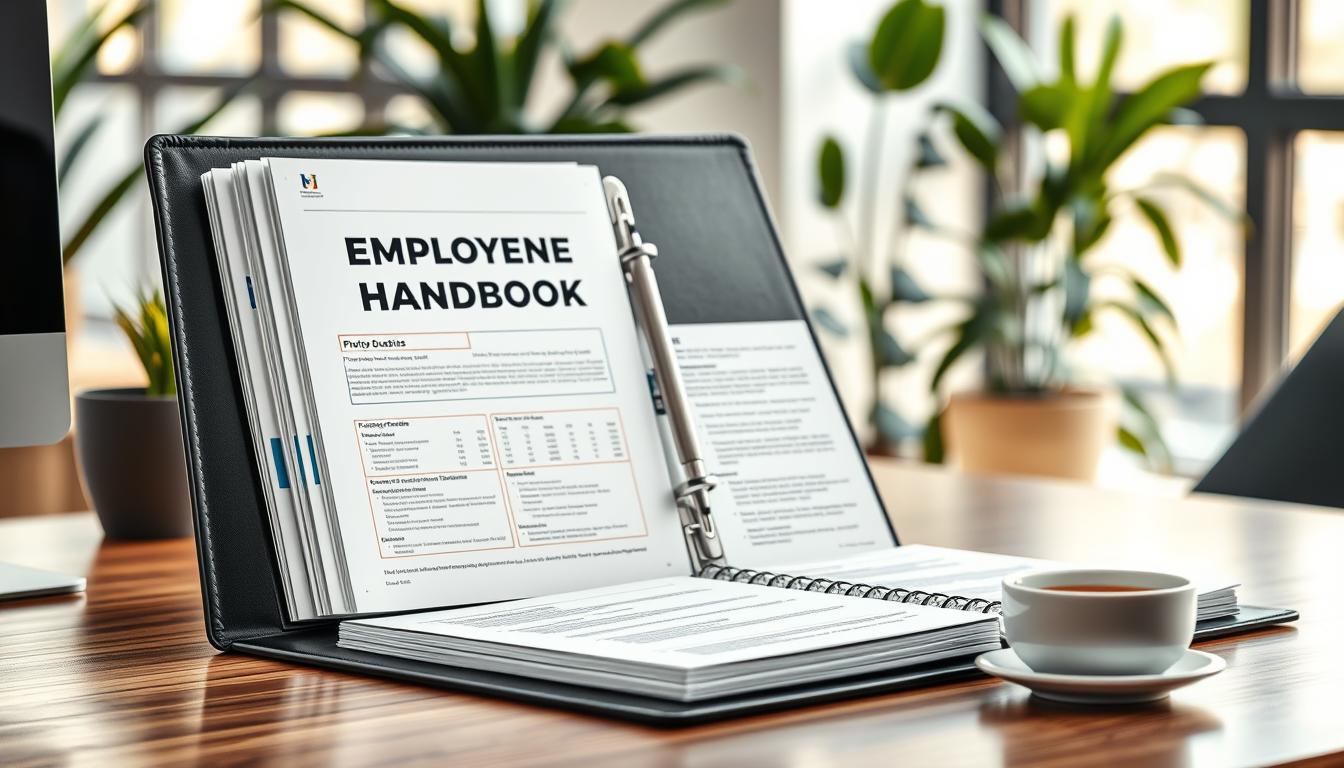Imagine a single document that could make your NEMT company run smoother and follow the law better. An effective NEMT employee handbook does more than list rules. It creates a unified system that matches your company’s goals and values. This guide helps your non-emergency medical transportation team follow confidentiality, equal job chances, and the Americans with Disabilities Act (ADA).
By adding detailed NEMT staff policies, your team knows their duties and the company’s dedication to a fair workplace. Updates, like the changes on June 13, 2019, show how crucial it is to keep up with laws. This protects everyone involved.
Key Takeaways
- An NEMT Employee Handbook is essential for operational efficiency and legal compliance.
- Includes key policies such as confidentiality, equal employment opportunity, and ADA compliance.
- Ensures that staff understand their roles, responsibilities, and the company’s core values.
- The handbook, last revised on June 13, 2019, emphasizes compliance with up-to-date laws.
- Non-discrimination and affirmative action policies are pivotal to the company’s mission.
- Provides legal protections and clear guidelines for employee conduct and disciplinary procedures.
Introduction to Employee Handbooks for NEMT
Employee handbooks are key for Non-Emergency Medical Transportation (NEMT) services. They offer NEMT HR documentation like those for Modivcare. These handbooks outline employment, conduct, and operational procedures.
With a detailed handbook, your employees know company policies and benefits. It covers important topics like eligibility, billing, fraud prevention, and communication. This helps your team work together efficiently.
Modivcare’s handbook shows the value of clear information. It includes details on:
- Policies on service eligibility and reimbursement.
- Guidelines for making reservations, needing a five-day notice.
- 24-hour toll-free access for urgent trips.
- Details on bus tickets, tokens, and gas reimbursements.
This approach supports compliance and focuses on customer needs. The handbook is updated regularly, showing the industry’s fast pace.
Having Staff guidelines for NEMT in your handbook is essential. It helps your team work smoothly. With clear NEMT HR documentation, your employees can do their jobs well, keeping NEMT services reliable.
Essential Policies and Procedures
Creating an employee handbook is key for NEMT staff to know and follow important rules. We’ll cover three main topics: Confidentiality Statement, Equal Employment Opportunity, and ADA compliance. These are the core of a fair and welcoming work place.
Confidentiality Statement
Keeping information private is crucial in NEMT. A strong confidentiality statement teaches staff to guard medical and company secrets. This builds trust with your company, employees, and clients, keeping your services reliable.
Equal Employment Opportunity
Equal employment in NEMT means a diverse and welcoming work place. An EEO policy shows you’re against discrimination based on race, gender, or religion. It creates a culture of respect and fairness, letting everyone contribute and grow with the company.
Americans with Disabilities Act (ADA)
Following ADA rules is a must in NEMT. The ADA requires making reasonable changes for people with disabilities. By following ADA, you ensure everyone has a fair shot at work, making your company more inclusive and avoiding legal trouble.
Risk Management and Safety Policies
In the Non-Emergency Medical Transportation (NEMT) sector, safety is key. You need solid procedures and the right insurance to keep everyone safe.
Commercial Auto Insurance is vital for covering car accidents. You also need General Liability Insurance, Professional Liability Insurance, and Workers’ Compensation to handle other risks.
Vantage Point Risk helps spot and lessen NEMT risks. They check vehicles regularly to avoid breakdowns and keep the fleet safe.
Putting safety first is essential. This means training staff well and encouraging them to speak up about safety concerns. Using tech like GPS and driver monitoring systems also boosts safety.
Here’s what NEMT providers need for safety:
- Effective Fleet Maintenance: Regular checks and upkeep keep vehicles safe and reliable.
- Driver Safety Training: Ongoing training and reviews keep drivers ready and informed.
- Emergency Response Plans: Having plans for accidents or emergencies is crucial.
- Updating and Testing: Regular updates and tests for staff ensure they’re ready for anything.
- Drug and Alcohol Testing: Keeping a drug-free workplace protects everyone from dangers.
By following these strategies, NEMT providers can make their environment safer. This aligns with their goals to keep safety high and risks low.
Conduct, Discipline, and Performance Expectations
The NEMT Employee Handbook sets clear rules for workplace behavior. It covers expected actions, disciplinary steps, and how to perform well. This part is key to keeping the work place respectful and efficient.
Employee Conduct
NEMT staff’s actions are crucial for a good client experience. They must act with honesty, integrity, and fairness. Harassment, discrimination, and breaking rules are not allowed.
Following these rules is a must. It ensures ethical and respectful interactions. This is vital for top-notch Non-Emergency Medical Transportation services.
Disciplinary Procedures
There are rules for handling misconduct. These steps are fair, clear, and consistent. They go from a simple talk to firing, based on the offense.
Having these rules helps keep the service reliable and trustworthy. It’s good for both NEMT clients and staff.
| Reasons for Disciplinary Action | Potential Consequences |
|---|---|
| Harassment or Discrimination | Verbal Warning, Suspension, Termination |
| Violation of Company Policies | Written Warning, Probation |
| Insubordination | Suspension, Possible Termination |
| Mishandling of Client Information | Termination |
Following these rules keeps things fair and consistent. It also helps NEMT keep its good name. Keeping staff behavior high is key for reliable healthcare transport.
NEMT Employee Handbook
The NEMT Employee Handbook is key for setting clear rules and expectations for workers in the Non-Emergency Medical Transportation (NEMT) field. It talks about important things like job terms and how to keep service quality high.
Employment At-Will
At-will employment NEMT rules are important for both bosses and workers. This means either side can end the job anytime for a legal reason. A clear at-will policy helps manage what’s expected and gives a legal base for ending jobs when needed.
Attendance and Punctuality
Being on time is key for NEMT success. Being on time shows the quality of care to clients and shows the service’s reliability and professionalism. Following this rule builds trust and improves the company’s image.
To manage rides well, workers must plan rides at least two days before a medical visit. This makes sure everything runs smoothly, improving service quality and reliability.
| Service Type | Reimbursement Rate |
|---|---|
| Volunteer/ Foster Care Parent | $0.67/mile |
| Wheelchair Lift/Medi-Van | $35/round-trip + $0.67/mile |
Workers must keep detailed records of their trips. This includes start and end times to follow rules and get fair pay. It makes sure everyone gets what they deserve.
Having these rules in the NEMT Employee Handbook helps businesses follow laws, be clear, and work better together.
Employee Benefits and Compensation
It’s important to know about the benefits and compensation you get. These rewards show your hard work is valued and help keep you happy and healthy. Check out our NEMT Employee Handbook for all the details. It helps build trust and openness in our team.
Benefits Overview
Our NEMT team gets many benefits to help them grow personally and professionally. These include:
- Health Insurance: Plans that cover medical, dental, and vision.
- Retirement Plans: 401(k) plans with employer match for your future.
- Leave Policies: Lots of paid time off (PTO) for vacation and sick leave.
“An eligible beneficiary is defined as ‘an individual who has been determined eligible and is currently receiving Medicaid.'”
Compensation Structure
The way we pay NEMT employees is fair and shows we value their work. Key parts are:
| Role | Base Salary | Performance Bonus |
|---|---|---|
| Driver | $35,000 – $45,000 | Up to $5,000 |
| Dispatcher | $40,000 – $50,000 | Up to $7,000 |
| Administrative Staff | $30,000 – $40,000 | Up to $3,000 |
How much you earn depends on your performance and experience. We also consider the different needs of our team. For more info, see the latest NEMT Employee Handbook. It helps you understand and use all the benefits available to you.
Training and Orientation for NEMT Staff
NEMT staff training is key to making sure employees do their jobs well. Orientation programs NEMT help new staff fit in and learn the latest. They also keep everyone up-to-date with new practices and standards.
Staff Orientation
Good orientation programs NEMT teach new employees about the company’s basics. They learn about the mission, values, and how things work. They also get a 12-hour training on safety and customer service.
Staff must pass a DOT physical and have a clean record. They also go through drug and alcohol tests. This is crucial for a safe and reliable service.
Ongoing Training
After the initial training, NEMT focuses on ongoing learning. Regular sessions keep staff informed on new rules and service improvements. They also learn about the best ways to do their jobs.
Staff must also report on vehicle conditions and mileage correctly. This keeps them up-to-date with laws and improves service quality.
| Requirement | Description |
|---|---|
| Department Training Course | 12-hour mandatory training covering safety protocols and service standards. |
| Drug and Alcohol Testing | Pre-employment, random, post-accident, and reasonable suspicion testing. A positive result of 0.02 or above leads to termination. |
| Driver’s License Check | Drivers must consistently maintain a clean record with no more than 6 points. |
| Documentation Submissions | Employees must submit VCRs, mileage sheets, and student count sheets promptly and legibly. |
| Physical Examination | Passing a DOT physical to ensure fitness for duty. |
Operational Guidelines and Procedures
Effective NEMT operations management is key for smooth daily activities and keeping vehicles in top shape. Non-emergent medical transportation (NEMT) helps Health First Colorado members get to medically necessary services. Following these guidelines ensures service runs smoothly.
Daily Operations
Daily operations include set routines and dispatch rules to manage client transport well. It’s vital to have clear rules for driver assignments, trip planning, and route optimization. This improves NEMT operations management.
Using standard dispatch methods helps answer transport requests quickly and keeps service reliable.
Vehicle Maintenance
Keeping NEMT vehicles in good shape is crucial for safe and reliable medical transport. Regular checks and services are key to spotting and fixing mechanical problems fast. This approach reduces breakdowns and meets safety standards.
Regular maintenance, like tire checks, oil changes, and brake inspections, prevents unexpected failures. This boosts overall NEMT service quality.
| Task | Frequency | Importance |
|---|---|---|
| Pre-Trip Inspections | Daily | High |
| Oil Changes | Every 3,000 miles | High |
| Tire Pressure Checks | Bi-weekly | Medium |
| Brake Inspections | Monthly | High |
By following these operational guidelines, your service can excel in NEMT operations management. It ensures reliability and safety in maintaining NEMT vehicles.
Compliance and Legal Requirements
Understanding NEMT legal compliance is key. It involves following rules at county, state, and federal levels. Keeping your Non-Emergency Medical Transportation (NEMT) up to date is crucial. This includes following Medicaid rules and handling legal issues to avoid fines.
Between FY 2015 and FY 2016, reviews showed important points for NEMT operators. County Departments of Social Services (DSSs) had 30 days to fix problems. They also had to submit plans to correct issues.
Visits were usually scheduled with 10 business days’ notice. They were done in one day.
Keeping records, tracking trips, and following safety rules are key. DSSs need to send 6 important documents. Sharing information online is preferred.
Legal compliance also means checking vehicles and drivers. Vehicles must pass safety checks. Drivers need special tests and clean records.
“Following regulatory adherence NEMT rules is essential. Not following them can lead to fines, criminal charges, or being banned from federal programs.”— NEMT Compliance Expert
Insurance and proper documents are also important. Vehicles must have first aid kits and communication devices. HIPAA rules are strict, with fines up to $50,000 for breaking them.
Ensuring passengers with disabilities have access is crucial. Following the Americans with Disabilities Act (ADA) is required. This includes helping passengers and securing their mobility aids.
Responsibilitiesfor NEMT providers include fighting fraud in Medicaid. Misusing funds or breaking rules can lead to serious penalties. Checking employees and following the LEIE list are also required.
To stay compliant, use online tools like MAC portals and the HETS system. Following CMS guidelines for billing is also vital to avoid fines.
| Compliance Activity | Description | Requirements |
|---|---|---|
| On-Site Visits | Consultant reviews of county NEMT programs | 10 days’ notice, 1-day visit |
| Corrective Action | Address and correct identified deficiencies | 30 days deadline |
| Documentation Submission | Policy documents, vendor contracts, resource lists | 6 essential documents |
| Vehicle Maintenance | Regular inspections for safety compliance | Inspection of brakes, tires, seat belts, lights |
| Driver Qualifications | Ensure proper licensing and clean records | Pass tests, background checks, medical certifications |
| Health and Safety | Equipment and data protection | First aid kits, fire extinguishers, HIPAA compliance |
| Fraud Detection | Identify and mitigate fraudulent activities | Employee screenings, LEIE adherence |
| Rider Eligibility | Use online systems to verify rider information | MAC portals, HETS system |
By following these rules, NEMT providers can meet NEMT legal compliance standards. They also ensure safe and reliable transport for passengers. Regular policy updates are key to maintaining high service and legal standards.
Conclusion
Finalizing NEMT policies is key to your non-emergency medical transport (NEMT) success. This step ensures your services run smoothly and meet high standards. It covers customer service, safety, and following the law.
The NEMT handbook keeps your team informed about important rules. This includes safety, conduct, and how to perform well. It’s crucial for your team to follow these rules to keep passengers safe and happy.
Keeping the handbook up to date is important. This means adding new rules and training staff regularly. This way, your team can always offer the best service. Your goal is to provide safe and reliable transport, and your team’s help is essential.
FAQ
What is the purpose of the NEMT Employee Handbook?
The NEMT Employee Handbook is a detailed guide. It explains our mission, values, and roles. It also covers policies on confidentiality, equal opportunity, and safety. This helps keep operations smooth and protects everyone involved.
What is included in the Confidentiality Statement?
The Confidentiality Statement teaches employees to keep company and client info safe. This includes medical data and business secrets. It’s all about protecting privacy and integrity in NEMT services.
How does the company ensure equal employment opportunities?
Our Equal Employment Opportunity policy fights discrimination. It makes sure our workplace is diverse and welcoming. This policy helps create a fair and inclusive work environment.
What are the main components of risk management and safety policies in NEMT?
Our handbook focuses on keeping staff and passengers safe. It talks about insurance, risk strategies, and emergency plans. These steps help prevent accidents and ensure safety.
How does the employee conduct policy address workplace behavior?
The Employee Conduct policy sets clear rules for behavior. It bans harassment and discrimination. It aims to keep the workplace respectful and professional.
What are Disciplinary Procedures?
Disciplinary Procedures handle misconduct fairly. They outline steps and possible penalties for policy breaches. This ensures consistent treatment of employees.
What is the meaning of Employment At-Will in the NEMT Employee Handbook?
Employment At-Will means jobs can end anytime for legal reasons. It gives both sides flexibility. It shows that jobs can change as needed.
Why are Attendance and Punctuality important?
Being on time and present is key for good NEMT service. It affects client care and our reputation. Reliable service is crucial.
What types of benefits are available to NEMT staff?
Our handbook lists employee benefits like health insurance and retirement plans. These support employee well-being and financial security.
How does the Compensation Structure work?
The Compensation Structure explains pay based on job and performance. It ensures fair pay for employees’ hard work.
What is included in Staff Orientation?
Staff Orientation introduces new employees to our culture and rules. It’s key for effective job performance and team integration.
What is the purpose of Ongoing Training?
Ongoing Training keeps service levels high and employees skilled. It’s vital for company and employee growth.
What are the key elements of Daily Operations?
Daily Operations cover routine tasks and client interactions. These guidelines help keep NEMT services efficient and responsible.
How important is Vehicle Maintenance?
Vehicle Maintenance is essential for safe transport. Regular checks and repairs are crucial for safety and service continuity.
What are the Compliance and Legal Requirements in NEMT?
NEMT must follow laws and regulations. This includes Medicaid rules and licensing. It ensures service quality and legal compliance.


